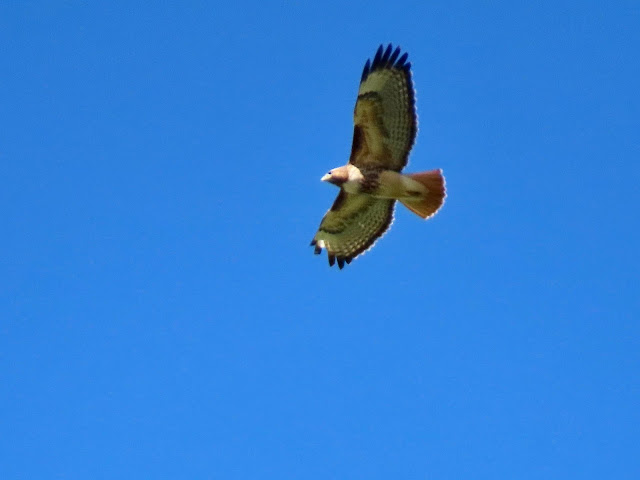Saturday, February 1, 2020
As I was preparing to leave the house on Friday evening, I received a text from Muriel N. wanting to know if I wanted to bird Thrasher Corner (at Baseline & Salome Hwy) with her tomorrow (Saturday). Although I had been to the Phoenix West Valley six days ago, I wanted very much to join her. (Impossible to cover all the spots in one trip.) With a quick question of where and when to meet her the next morning, I was out the door for an evening of crystal bowl/gong meditation.
The spontaneous meet up produced some really good birds for both of us in another day of good weather, from chilly to quite warm.
Our target bird at the Thrasher spot is always the LeCONTE'S THRASHER, a very plain and pale gray thrasher with no clear identifying marks. Its black beady eye helps to differentiate it from some of the other thrashers we'd find there. Because it prefers salt-brush and creosote desert scrub, its habitat is very restricted. Lucky us to have just the kind of habitat it prefers. Birders from all over the country/world come to this very spot if they are "listers" and need the bird to fill out their Life List.
At 7:30 a.m., Muriel pulled up behind two other vehicles already present; the birders already out in the field.
We knew Gordon, Cindy, Jeanne and Barb (through our binoculars). We waved to one another and slowly wandered their direction picking up a few birds of our own (WHITE-CROWNED SPARROW, VERDIN, BLACK-TAILED GNATCATCHER).
Then, we heard the LeCONTE'S THRASHER singing. Beyond us, the other birders had their scope on it. We had a bit of a view through a line of thick bushes and were very careful about not rushing forward until the other group moved. Already, I had squeezed off an e-Bird acceptable photo. But with such a rarity, I always like as many photos as I can get showing off its front, back, and sides. As we all proceeded forward quietly, we were rewarded.
 |
| LeCONTE'S THRASHER (3 photos) |
 |
| Morning light giving the thrasher a brown hue (it's mostly gray) |
 |
| Front view shows its dark eye, light throat and dark throat stripe. Tail is long and dark; undertail coverts are cinnamon colored. |
 |
| BLACK-TAILED GNATCATCHER (chasing each other and chattering) |
 |
| Rare to hear a LOGGERHEAD SHRIKE perched up singing! |
 |
| SAGEBRUSH SPARROW |
 |
| BENDIRE'S THRASHER |
 |
| With a long decurved bill, the CRISSAL THRASHER differs from the LeCONTE's with its light eye. |
View this checklist online at https://ebird.org/checklist/S64002135
Driving, then, for about 1.5 hours around Arlington's ag fields and ponds, we came upon one good sighting after another....EXCEPT at the Hot Spot for the Ruddy Ground-Dove. We missed them again today as happened last Sunday! We weren't doing a "must have this bird" approach, but did sort through many many Mourning, Eurasian Collared and Inca Doves in our search for a smaller very ruddy-colored dove with a dark tail.
Today, the birds in the fields were closer to the roadways allowing for more detailed photos.
 |
| WHITE-FACED IBIS Note the thin line of white feathers at base of its bill. Feathers will thicken as breeding time approaches. |
 |
| GREATER YELLOWLEGS - usually seen at ponds or shorelines. Here, they're foraging in irrigated fields. |
 |
| ANNA'S HUMMINGBIRD |
The best was ahead of us. Muriel loves the hawks and was targeting the Harlan's Red-tailed. Aware of its recent last report, we headed that direction in Buckeye.
Wow! Quite a kettle of raptors and a few TURKEY VULTURES. I rarely see that many hawks at a time; I was in awe of the challenge of sorting what I was seeing. Clicking off photos was my method -- I needed to study and learn the differences among the RED-TAILED HAWK. Unfortunately, Muriel's target "Harlan's" Red-tailed Hawk was a no-show.
 |
| Light Adult RED-TAILED HAWK |
 |
| Light Juvenile RED-TAILED HAWK |
 |
| Adult Rufous RED-TAILED HAWK |
 |
| Juvenile Rufous RED-TAILED HAWK |
A probable second-year BALD EAGLE (based on the amount of white feathers) seemed very dark and very large. It flew up so close that I was able to photograph the top of it.
 |
| Immature BALD EAGLE |
 |
| Immature BALD EAGLE |
 |
| In flight, the young BALD EAGLE glides with flat wings. |
 |
| Later, that same young Bald Eagle swooped low over the field, then lifted off and away. |
The adult BALD EAGLE was not far behind its youngster.
 |
| Adult BALD EAGLE calling to its young |
 |
| Light FERRUGINOUS HAWK (above & below) |
I don't recall ever getting "high on hawks" before, but that was a memorable experience. Thank you, Muriel!
View this checklist online at https://ebird.org/checklist/S64012289
View this checklist online at https://ebird.org/checklist/S64044516
* * *




No comments:
Post a Comment